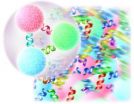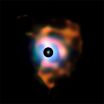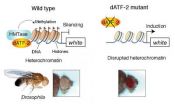(Press-News.org) In its infancy, when the universe was a few millionths of a second old, the elemental constituents of matter moved freely in a hot, dense soup of quarks and gluons. As the universe expanded, this quark–gluon plasma quickly cooled, and protons and neutrons and other forms of normal matter "froze out": the quarks became bound together by the exchange of gluons, the carriers of the color force.
"The theory that describes the color force is called quantum chromodynamics, or QCD," says Nu Xu of the U.S. Department of Energy's Lawrence Berkeley National Laboratory (Berkeley Lab), the spokesperson for the STAR experiment at the Relativistic Heavy Ion Collider (RHIC) at DOE's Brookhaven National Laboratory. "QCD has been extremely successful at explaining interactions of quarks and gluons at short distances, such as high-energy proton and antiproton collisions at Fermi National Accelerator Laboratory. But in bulk collections of matter – including the quark-gluon plasma – at longer distances or smaller momentum transfer, an approach called lattice gauge theory has to be used."
Until recently, lattice QCD calculations of hot, dense, bulk matter could not be tested against experiment. Beginning in 2000, however, RHIC was able to recreate the extreme conditions of the early universe in miniature, by colliding massive gold nuclei (heavy ions) at high energies.
Experimentalists at RHIC, working with theorist Sourendu Gupta of India's Tata Institute of Fundamental Research, have recently compared lattice-theory predictions about the nature of the quark-gluon plasma with certain STAR experimental results for the first time. In so doing they have established the temperature boundary where ordinary matter and quark matter cross over and change phase. Their results appear in the journal Science.
Phase diagrams
The aim of both the theoretical and experimental work is to explore and fix key points in the phase diagram for quantum chromodynamics. Phase diagrams are maps, showing, for example, how changes in pressure and temperature determine the phases of water, whether ice, liquid, or vapor. A phase diagram of QCD would map the distribution of ordinary matter (known as hadronic matter), the quark-gluon plasma, and other possible phases of QCD such as color superconductivity.
"Plotting a QCD phase diagram requires both theory calculations and experimental effort with heavy-ion collisions," says Xu, who is a member of Berkeley Lab's Nuclear Science Division and an author of the Science paper. Experimental studies require powerful accelerators like RHIC on Long Island or the Large Hadron Collider at CERN in Geneva, while calculations of QCD using lattice gauge theory require the world's biggest and fastest supercomputers. Direct comparisons can achieve more than either approach alone.
One of the basic requirements of any phase diagram is to establish its scale. A phase diagram of water might be based on the Celsius temperature scale, defined by the boiling point of water under normal pressure (i.e., at sea level). Although the boiling point changes with pressure – at higher altitudes water boils at lower temperatures – these changes are measured against a fixed value.
The scale of the QCD phase diagram is defined by a transition temperature at the zero value of "baryon chemical potential." Baryon chemical potential measures the imbalance between matter and antimatter, and zero indicates perfect balance.
Through extensive calculations and actual data from the STAR experiment, the team was indeed able to establish the QCD transition temperature. Before they could do so, however, they first had to realize an equally significant result, showing that the highly dynamical systems of RHIC's gold-gold collisions, in which the quark-gluon plasma winks in and out of existence, in fact achieve thermal equilibrium. Here's where theory and experiment worked hand in hand.
"The fireballs that result when gold nuclei collide are all different, highly dynamic, and last an extremely short time," says Hans Georg Ritter, head of the Relativistic Nuclear Collisions program in Berkeley Lab's Nuclear Science Division and an author of the Science paper. Yet because differences in values of the kind observed by STAR are related to fluctuations in thermodynamic values predicted by lattice gauge theory, says Ritter, "by comparing our results to the predictions of theory, we have shown that what we measure is in fact consistent with the fireballs reaching thermal equilibrium. This is an important achievement."
The scientists were now able to proceed with confidence in establishing the scale of the QCD phase diagram. After a careful comparison between experimental data and the results from the lattice gauge theory calculations, the scientists concluded that the transition temperature (expressed in units of energy) is 175 MeV (175 million electron volts).
Thus the team could develop a "conjectural" phase diagram that showed the boundary between the low-temperature hadronic phase of ordinary matter and the high-temperature quark-gluon phase.
In search of the critical point
Lattice QCD also predicts the existence of a "critical point." In a QCD phase diagram the critical point marks the end of a line showing where the two phases cross over, one into the other. By changing the energy, for example, the baryon chemical potential (balance of matter and antimatter) can be adjusted.
Among the world's heavy-ion colliders, only RHIC can tune the energy of the collisions through the region of the QCD phase diagram where the critical point is most likely to be found – from an energy of 200 billion electrons volts per pair of nucleons (protons or neutrons) down to 5 billion electron volts per nucleon pair.
Says Ritter, "Establishing the existence of a QCD critical point would be much more significant than setting the scale." In 2010, RHIC started a program to search for the QCD critical point.
Xu says, "In this paper, we compared experimental data with lattice calculations directly, something never done before. This is a real step forward and allows us to establish the scale of the QCD phase diagram. Thus begins an era of precision measurements for heavy-ion physics."
INFORMATION:
"Scale for the phase diagram of quantum chromodynamics," by Sourendu Gupta, Xiaofeng Luo, Bedangadas Mohanty, Hans Georg Ritter, and Nu Xu, appears in the 24 June 2011 issue of Science magazine. Gupta is with the Tata Institute of Fundamental Research in Mumbai, India, where the theoretical calculations for this paper were carried out. Mohanty is with the Variable Energy Cyclotron Centre in Kolkata, India, and was formerly a postdoctoral fellow at Berkeley Lab. Luo, Ritter, and Xu are with Berkeley Lab's Nuclear Science Division. Luo is also with the University of Science and Technology of China in Hefei, and Xu is also with the Central China Normal University in Wuhan. This work was supported by the Indian Lattice Gauge Theory Initiative, by India's Department of Atomic Energy-Board of Research in Nuclear Sciences, the National Science Foundation of China, the Chinese Ministry of Education, and by DOE's Office of Science.
Lawrence Berkeley National Laboratory addresses the world's most urgent scientific challenges by advancing sustainable energy, protecting human health, creating new materials, and revealing the origin and fate of the universe. Founded in 1931, Berkeley Lab's scientific expertise has been recognized with 12 Nobel prizes. The University of California manages Berkeley Lab for the U.S. Department of Energy's Office of Science. For more, visit www.lbl.gov.
When matter melts
By comparing theory with data from STAR, Berkeley Lab scientists and their colleagues map phase changes in the quark-gluon plasma
2011-06-24
ELSE PRESS RELEASES FROM THIS DATE:
Effects of stress can be inherited, and here's how
2011-06-24
None of us are strangers to stress of various kinds. It turns out the effects of all those stresses can change the fate of future generation, influencing our very DNA without any change to the underlying sequence of As, Gs, Ts and Cs. Now, researchers reporting in the June 24th issue of Cell, a Cell Press publication, have new evidence that helps to explain just how these epigenetic changes really happen.
"There has been a big discussion about whether the stress effect can be transmitted to the next generation without DNA sequence change," said Shunsuke Ishii of RIKEN ...
How to Avoid Harm at the Doctor's Office After a Tampa Car Accident
2011-06-24
A doctor's office visit can be stressful, no matter what the circumstances, but imagine if you're visiting your doctor after you've been injured in a car accident.
If you've spoken with an attorney about your Florida motor vehicle accident, your attorney may have counseled you on how to protect your accident claim in the exam room. If you haven't spoken to an attorney, there are mistakes you want to avoid to prevent damaging any possible claim you have.
Mistakes to Avoid at a Visit With Your Doctor
Don't Lie About Your Pain or Ignore Pain: The most common, and ...
Leftover embryonic cells connect gastric reflux and cancer
2011-06-24
The ultimate source of some cancers is embryonic cells. Research published in the June 24th Cell, a Cell Press publication, traces the precursor of deadly esophageal cancers to leftover embryonic cells found in all adults.
Some people with gastric reflux disease have a greater risk of developing esophageal cancer. These patients often have Barrett's esophagus, a condition in which intestinal-like cells appear in the esophagus. Esophageal cancers are difficult to treat and, together with gastric adenocarcinomas, kill more than a million people each year.
"A lot of ...
The flames of Betelgeuse
2011-06-24
Betelgeuse, a red supergiant in the constellation of Orion, is one of the brightest stars in the night sky. It is also one of the biggest, being almost the size of the orbit of Jupiter — about four and half times the diameter of the Earth's orbit. The VLT image shows the surrounding nebula, which is much bigger than the supergiant itself, stretching 60 billion kilometres away from the star's surface — about 400 times the distance of the Earth from the Sun.
Red supergiants like Betelgeuse represent one of the last stages in the life of a massive star. In this short-lived ...
Mechanism for stress-induced epigenetic inheritance uncovered in new study
2011-06-24
Researchers at RIKEN have uncovered a mechanism by which the effects of stress in the fly species Drosophila are inherited epigenetically over many generations through changes to the structure of chromatin, the material that makes up the cell nucleus. Published in the journal Cell, the results highlight the role of the transcription factor dATF-2 in chromatin assembly, marking a major advance in our understanding of non-Mendelian inheritance.
Recent years have seen growing interest in the phenomenon of epigenetic inheritance: the idea that our genome, through epigenetic ...
Senators Latest Target: Smartphone DUI Apps
2011-06-24
An app created by the Canadian based creators of Blackberry, Research In Motion, has recently been pulled off the company's online store after a formal request from four U.S. Senators.
Known as the "DUI app," it allows users to pinpoint the exact locations of local police checkpoints using GPS. The apps also locate traffic cameras and speed traps.
Web applications like these, however, are gaining widespread attention by law enforcement and legislative officials across the country.
Senators Harry Reid, D-Nevada; Charles Schumer, D-New York; Frank Lautenberg, ...
Oxytocin promises hope in Prader-Willi syndrome
2011-06-24
Prader-Willi syndrome is a rare genetic disorder which affects one child in 25,000. Children born with this syndrome have a range of complex neurological and developmental problems which continue into adult life. These can manifest as cognitive and behavioral difficulties, weight gain, problems in controlling their temper and attendant difficulties in socialization. New research published in BioMed Central's open access journal Orphanet Journal of Rare Diseases, demonstrates that the hormone oxytocin is able to positively affect patients by improving trust, mood, and reducing ...
Synthetic collagen from maize has human properties
2011-06-24
Synthetic collagen has a wide range of applications in reconstructive and cosmetic surgery and in the food industry. For proper function in animals a certain number of prolines within the protein need to be hydroxylated. BioMed Central's open access journal BMC Biotechnology reports that for the first time the α1 chain of type 1 collagen has been produced in maize with similar levels of proline hydroxylation to human collagen.
Most collagen used is derived from animals but there are risks associated with this collagen containing infectious agents or being rejected ...
A thermometer for dinosaurs
2011-06-24
Small heads, large bodies, and a slow metabolism -- these are the characteristics that make us think of dinosaurs as dull, lethargic and cold-blooded giants. However, this image seems to be deceiving. These giant saurians that have been extinct for 65 million years may have been high-performance models of evolution. In cooperation with colleagues from the US, researchers from the University of Bonn have just determined that the body temperature of some large herbivorous dinosaurs was between 36 and 38 degrees Celsius. "Originally, dinosaurs were considered to have been ...
Discovering lost salmon at sea
2011-06-24
Where Atlantic salmon feed in the ocean has been a long-standing mystery, but new research led by the University of Southampton shows that marine location can be recovered from the chemistry of fish scales. Surprisingly, salmon from different British rivers migrate to feed in separate places, and may respond differently to environmental change.
Numbers of Atlantic salmon have declined across their range since the early 1970s, and most researchers believe that conditions experienced at sea are largely to blame. Unfortunately, identifying where salmon go to feed in the ...
LAST 30 PRESS RELEASES:
NTIDE: Disability employment holds steady after data hiatus
Social lives of viruses affect antiviral resistance
Dose of psilocybin, dash of rabies point to treatment for depression
Helping health care providers navigate social, political, and legal barriers to patient care
Barrow Neurological Institute, University of Calgary study urges “major change” to migraine treatment in Emergency Departments
Using smartphones to improve disaster search and rescue
Robust new photocatalyst paves the way for cleaner hydrogen peroxide production and greener chemical manufacturing
Ultrafast material captures toxic PFAS at record speed and capacity
Plant phenolic acids supercharge old antibiotics against multidrug resistant E. coli
UNC-Chapel Hill study shows AI can dramatically speed up digitizing natural history collections
OYE Therapeutics closes $5M convertible note round, advancing toward clinical development
Membrane ‘neighborhood’ helps transporter protein regulate cell signaling
Naval aviator turned NPS doctoral student earns national recognition for applied quantum research
Astronomers watch stars explode in real time through new images
Carbon-negative building material developed at Worcester Polytechnic Institute published in matter
Free radicals caught in the act with slow spectroscopy
New research highlights Syntax Bio’s platform for simple yet powerful programming of human stem cells
Researchers from the HSE University investigated reading in adolescents
Penn Nursing study: Virtual nursing programs in hospitals fall short of expectations
Although public overwhelmingly supports hepatitis B vaccine for a newborn, partisan differences exist
DFW backs UTA research to bolster flood resilience
AI brain scan model identifies stroke, brain tumors and aneurysms – helping radiologists triage and speed up diagnoses
U.S. News & World Report gives Hebrew Rehabilitation Center highest rating
Optica and DPG name Antoine Browaeys 2026 Herbert Walther Award recipient
The presence of a gun in the home increases the risk of suicide by three to five times
PFAS exposure and endocrine disruption among women
Vaccines and the 2024 US presidential election
New approach narrows uncertainty in future warming and remaining carbon budget for 2 °C
When pregnancy emergencies collide with state abortion bans
American College of Cardiology supports front of package nutrition labeling
[Press-News.org] When matter meltsBy comparing theory with data from STAR, Berkeley Lab scientists and their colleagues map phase changes in the quark-gluon plasma



